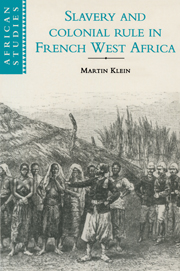Book contents
- Frontmatter
- Contents
- List of illustrations
- List of maps
- List of tables
- Preface
- List of abbreviations
- Glossary
- 1 Slavery in the Western Sudan
- 2 Abolition and retreat. Senegal 1848–1876
- 3 Slavery, slave-trading and social revolution
- 4 Senegal after Brière
- 5 Conquest of the Sudan: Desbordes to Archinard
- 6 Senegal in the 1890s
- 7 The end of the conquest
- 8 The imposition of metropolitan priorities on slavery
- 9 With smoke and mirrors: slavery and the conquest of Guinea
- 10 The Banamba Exodus
- 11 French fears and the limits to an emancipation policy
- 12 Looking for the tracks. How they did it
- 13 After the War: renegotiating social relations
- 14 A question of honor
- Appendixes
- Notes
- Bibliography
- Index
- Titles in the series
Appendixes
Published online by Cambridge University Press: 07 May 2010
- Frontmatter
- Contents
- List of illustrations
- List of maps
- List of tables
- Preface
- List of abbreviations
- Glossary
- 1 Slavery in the Western Sudan
- 2 Abolition and retreat. Senegal 1848–1876
- 3 Slavery, slave-trading and social revolution
- 4 Senegal after Brière
- 5 Conquest of the Sudan: Desbordes to Archinard
- 6 Senegal in the 1890s
- 7 The end of the conquest
- 8 The imposition of metropolitan priorities on slavery
- 9 With smoke and mirrors: slavery and the conquest of Guinea
- 10 The Banamba Exodus
- 11 French fears and the limits to an emancipation policy
- 12 Looking for the tracks. How they did it
- 13 After the War: renegotiating social relations
- 14 A question of honor
- Appendixes
- Notes
- Bibliography
- Index
- Titles in the series
Summary
APPENDIX 1 HOW MANY SLAVES?
How many slaves were there in the West African territories? This is a question we can never answer with precision. There are, however, enough data for us to venture a rough estimate. There are two major sources about the numbers of slaves in French West Africa. These are the responses to the slave questionnaires of 1894 in the Sudan and 1904 for all of French West Africa. In addition, there are local studies and censuses. There are major problems in using colonial data. Administrators were often ill informed about the societies they ruled and lacked the personnel to do a really efficient job of data collection. Furthermore, slavery was a touchy question. African slave-owners had good reason not to report fully their slave holdings because they feared French intentions. Similarly, many administrators were nervous about potential unrest and were hostile to any action against slavery. Many administrators in both 1894 and 1904 refused to estimate the slave population; others simply “eyeballed” it. Fortunately, we have more rigorous studies made by social scientists in the second half of the century which suggest that almost all early administrators underestimated the number of slaves.
Nevertheless, these are the data we have. Furthermore, there are some patterns and ways of checking them. In producing global estimates, I have used the following method. I start with the 1904 estimates. First, where I have absolute numbers, but no percentages, I use 1904 or 1905 population data to produce percentages. Second, where I have only percentages, I use the reverse process to estimate the number of slaves.
- Type
- Chapter
- Information
- Slavery and Colonial Rule in French West Africa , pp. 252 - 259Publisher: Cambridge University PressPrint publication year: 1998
- 1
- Cited by

